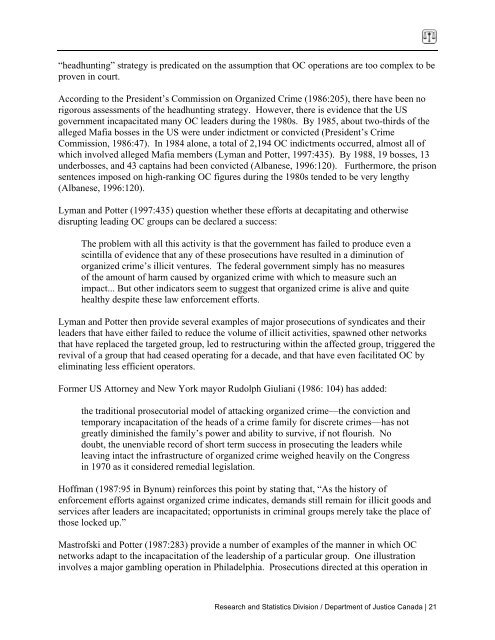Assessing the Effectiveness of Organized Crime Control Strategies ...
Assessing the Effectiveness of Organized Crime Control Strategies ...
Assessing the Effectiveness of Organized Crime Control Strategies ...
You also want an ePaper? Increase the reach of your titles
YUMPU automatically turns print PDFs into web optimized ePapers that Google loves.
“headhunting” strategy is predicated on <strong>the</strong> assumption that OC operations are too complex to be<br />
proven in court.<br />
According to <strong>the</strong> President’s Commission on <strong>Organized</strong> <strong>Crime</strong> (1986:205), <strong>the</strong>re have been no<br />
rigorous assessments <strong>of</strong> <strong>the</strong> headhunting strategy. However, <strong>the</strong>re is evidence that <strong>the</strong> US<br />
government incapacitated many OC leaders during <strong>the</strong> 1980s. By 1985, about two-thirds <strong>of</strong> <strong>the</strong><br />
alleged Mafia bosses in <strong>the</strong> US were under indictment or convicted (President’s <strong>Crime</strong><br />
Commission, 1986:47). In 1984 alone, a total <strong>of</strong> 2,194 OC indictments occurred, almost all <strong>of</strong><br />
which involved alleged Mafia members (Lyman and Potter, 1997:435). By 1988, 19 bosses, 13<br />
underbosses, and 43 captains had been convicted (Albanese, 1996:120). Fur<strong>the</strong>rmore, <strong>the</strong> prison<br />
sentences imposed on high-ranking OC figures during <strong>the</strong> 1980s tended to be very lengthy<br />
(Albanese, 1996:120).<br />
Lyman and Potter (1997:435) question whe<strong>the</strong>r <strong>the</strong>se efforts at decapitating and o<strong>the</strong>rwise<br />
disrupting leading OC groups can be declared a success:<br />
The problem with all this activity is that <strong>the</strong> government has failed to produce even a<br />
scintilla <strong>of</strong> evidence that any <strong>of</strong> <strong>the</strong>se prosecutions have resulted in a diminution <strong>of</strong><br />
organized crime’s illicit ventures. The federal government simply has no measures<br />
<strong>of</strong> <strong>the</strong> amount <strong>of</strong> harm caused by organized crime with which to measure such an<br />
impact... But o<strong>the</strong>r indicators seem to suggest that organized crime is alive and quite<br />
healthy despite <strong>the</strong>se law enforcement efforts.<br />
Lyman and Potter <strong>the</strong>n provide several examples <strong>of</strong> major prosecutions <strong>of</strong> syndicates and <strong>the</strong>ir<br />
leaders that have ei<strong>the</strong>r failed to reduce <strong>the</strong> volume <strong>of</strong> illicit activities, spawned o<strong>the</strong>r networks<br />
that have replaced <strong>the</strong> targeted group, led to restructuring within <strong>the</strong> affected group, triggered <strong>the</strong><br />
revival <strong>of</strong> a group that had ceased operating for a decade, and that have even facilitated OC by<br />
eliminating less efficient operators.<br />
Former US Attorney and New York mayor Rudolph Giuliani (1986: 104) has added:<br />
<strong>the</strong> traditional prosecutorial model <strong>of</strong> attacking organized crime—<strong>the</strong> conviction and<br />
temporary incapacitation <strong>of</strong> <strong>the</strong> heads <strong>of</strong> a crime family for discrete crimes—has not<br />
greatly diminished <strong>the</strong> family’s power and ability to survive, if not flourish. No<br />
doubt, <strong>the</strong> unenviable record <strong>of</strong> short term success in prosecuting <strong>the</strong> leaders while<br />
leaving intact <strong>the</strong> infrastructure <strong>of</strong> organized crime weighed heavily on <strong>the</strong> Congress<br />
in 1970 as it considered remedial legislation.<br />
H<strong>of</strong>fman (1987:95 in Bynum) reinforces this point by stating that, “As <strong>the</strong> history <strong>of</strong><br />
enforcement efforts against organized crime indicates, demands still remain for illicit goods and<br />
services after leaders are incapacitated; opportunists in criminal groups merely take <strong>the</strong> place <strong>of</strong><br />
those locked up.”<br />
Mastr<strong>of</strong>ski and Potter (1987:283) provide a number <strong>of</strong> examples <strong>of</strong> <strong>the</strong> manner in which OC<br />
networks adapt to <strong>the</strong> incapacitation <strong>of</strong> <strong>the</strong> leadership <strong>of</strong> a particular group. One illustration<br />
involves a major gambling operation in Philadelphia. Prosecutions directed at this operation in<br />
Research and Statistics Division / Department <strong>of</strong> Justice Canada | 21








